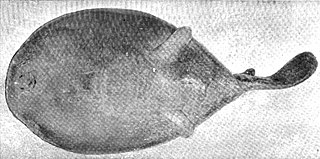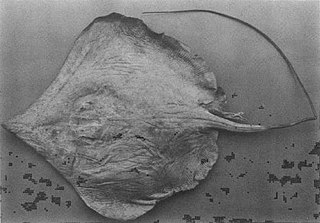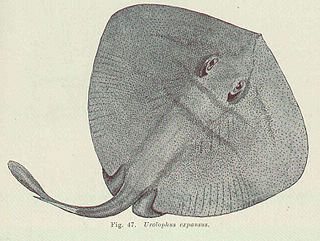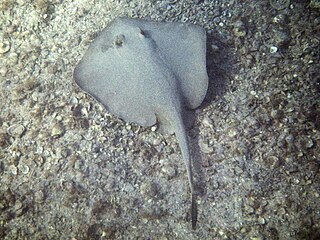
The prickly dogfish is a poorly known species of dogfish shark in the family Oxynotidae, inhabiting temperate Australian and New Zealand waters. Reaching a length of 75 cm (30 in), this brown to gray shark has a very thick body with a prominent "humpback" and extremely rough skin. It is further characterized by two enormous, sail-like dorsal fins placed relatively close together. Both dorsal fins have a spine embedded mostly within the fleshy leading portion of the fin; the first dorsal spine is tilted forward.

The thorntail stingray, black stingray, or longtail stingray is a species of stingray in the family Dasyatidae. It is found off southern Africa, Australia, and New Zealand from the intertidal zone to a depth of 440 m (1,440 ft). This bottom-dweller inhabits soft-bottomed habitats such as lagoons, estuaries, and reefs. Growing to 1.8 m (5.9 ft) across and over 200 kg (440 lb) in weight, the thorntail stingray is among the largest stingrays in the world. Uniformly dark above and light below, it has a diamond-shaped pectoral fin disc and a very long, whip-like tail with a fin fold underneath. The upper surface of the disc and the tail bear numerous stout, sharp thorns.

The oval electric ray is a little-known species of sleeper ray in the family Narkidae. It is endemic to New Zealand, where it is generally found on the sea floor at a depth of 300–400 m (980–1,310 ft). Seldom exceeding 30 cm (12 in) in length, this species has a thick, oval pectoral fin disc and a short, stout tail with a single dorsal fin. It is blind, as its tiny eyes are covered by skin. Its pelvic fins are divided in two, with the anterior portion forming a limb-like appendage. These appendages likely allow the ray, which may not be able to swim at all, to "walk" along the bottom. The claspers of adult males extend beyond the disc. Polychaete worms are known to be part of its diet, and its reproduction is aplacental viviparous. It can produce an electric shock for defense. The International Union for Conservation of Nature presently lacks the data to assess its conservation status.

The mouse catshark is a species of catshark and part of the family Scyliorhinidae. It is common in the northeastern Atlantic Ocean from Iceland to Western Sahara. There is much taxonomic confusion regarding this species in Icelandic waters, where it may be confounded with another species of Galeus or Apristurus. Probably not exceeding 49 cm (19 in) long, the mouse catshark has a uniformly brown body and is characterized by large, rounded pelvic fins and crests of enlarged dermal denticles along both the dorsal and ventral caudal fin margins. In addition, in adult males the inner margins of the pelvic fins are merged into an "apron".

The sharpnose stingray is a little-known species of stingray in the family Dasyatidae, found off southern Japan and in the East China Sea. With a rounded pectoral fin disc and a long, projecting snout, T. acutirostra resembles the smaller pale-edged stingray. A number of characteristics differentiate this species from T. zugei, including larger eyes and the absence of a dorsal fin fold on the tail. The International Union for Conservation of Nature (IUCN) has assessed this species as Near Threatened, as its restricted distribution renders it vulnerable to increases in fishing pressure.

The plain maskray or brown stingray, is a species of stingray in the family Dasyatidae. It is found in shallow, soft-bottomed habitats off northern Australia. Reaching 24 cm (9.4 in) in width, this species has a diamond-shaped, grayish green pectoral fin disc. Its short, whip-like tail has alternating black and white bands with fin folds above and below. There are short rows of thorns on the back and the base of the tail, but otherwise the skin is smooth. While this species possesses the dark mask-like pattern across its eyes common to its genus, it is not ornately patterned like other maskrays.

The ocellated electric ray or bullseye electric ray is a species of electric ray in the family Narcinidae, native to the shallow inshore waters of the eastern central Pacific from the Gulf of California to Ecuador. Reaching 25 cm (9.8 in) in length, this species has a rounded pectoral fin disc and pelvic fins with convex margins. Its short and thick tail bears two dorsal fins and terminates in a triangular caudal fin. The ocellated electric ray is named for the distinctive large eyespot on the middle of its disc, consisting of a black or yellow center surrounded by concentric rings. Its dorsal coloration is otherwise highly variable, ranging from plain to ornately patterned on a light to dark brown background. The front part of its disc is darker brown.
The Aden Gulf torpedo or Aden torpedo is a poorly known species of electric ray in the family Torpedinidae, seemingly endemic to the eastern Gulf of Aden, near the coast of Yemen. Growing to 41 cm (16 in) long, this species has a nearly circular pectoral fin disc and a short, thick tail with two dorsal fins and a well-developed caudal fin. It is characterized by its reddish dorsal coloration, which in contrast to related species lacks any additional markings. The International Union for Conservation of Nature (IUCN) has assessed the Aden Gulf torpedo as Endangered, citing its extremely small range and the intensive shrimp trawling that occurs in the region.

The Gulf torpedo or variable electric ray, is a species of electric ray in the family Torpedinidae. It is found in the Indian Ocean, but may represent a species flock of several local endemic species. It is distinguishable from other Torpedo species in its range by its ornate dorsal coloration. Another common name, marbled electric ray, is not to be confused with Torpedo marmorata.

The wide stingaree is a little-known species of stingray in the family Urolophidae, found off southwestern Australia. It typically occurs over sand in water 200–300 m (660–980 ft) deep around the edge of the continental shelf. This species has a broad diamond-shaped pectoral fin disc, a slightly pointed snout, and a tail with a leaf-like caudal fin, skin folds along either side, and no dorsal fins. Between its nostrils is a skirt-shaped curtain of skin. It is grayish green above, with faint bluish lines beside and behind the eyes. The maximum length on record is 52 cm (20 in).

The Kapala stingaree is a species of stingray in the family Urolophidae, endemic to inshore waters off southeastern Queensland and New South Wales. It is commonly found on and around rocky reefs at a depth of 10–130 m (33–427 ft). Reaching 51 cm (20 in) in length, the Kapala stingaree has a rounded, diamond-shaped pectoral fin disc and a slender tail, which ends in a leaf-shaped caudal fin and bears lateral skin folds and a small dorsal fin in front of the stinging spine. It has a distinctive bell-shaped curtain of skin between its nostrils. This species is greenish above, with a highly variable pattern of dark markings usually found outside and between the eyes, and over the back and tail.

The greenback stingaree is a little-known species of stingray in the family Urolophidae, endemic to the outer continental shelf and upper continental slope off southeastern Australia. Growing to a length of 51 cm (20 in), this species has a diamond-shaped pectoral fin disc wider than long and uniformly light green in color above. Between its nostrils is a skirt-shaped curtain of skin. Its tail bears skin folds on either side and a deep, lanceolate caudal fin, but lacks a dorsal fin.

The finless sleeper ray is a species of electric ray in the family Narkidae, and the sole member of its genus. It is found over the continental shelf of Southeast Asia from the eastern Andaman Sea to Vietnam and Borneo. Typically growing no more than 15 cm (5.9 in) long, it may be the smallest cartilaginous fish. The finless sleeper ray is the only electric ray that lacks dorsal fins. It has an oval pectoral fin disc that varies from longer than wide to wider than long, depending on age, and a short, robust tail that terminates in a short, deep caudal fin. The trailing margins of its pelvic fins are sexually dimorphic, being more concave in males.

The mangrove whipray or whitetail stingray, is a species of stingray in the family Dasyatidae. It is widely distributed in the Indo-Pacific region from the Red Sea to northern Australia and Micronesia. A benthic inhabitant of shallow inshore waters, juvenile mangrove whiprays favor mangrove and estuarine habitats, while adults favor sandy to rocky areas in lagoons and coral reefs. This species can be identified by its thick, oval pectoral fin disc that is dark gray above with numerous white flecks, and by its relatively short, whip-like tail that is white past the stinging spine. It grows up to 1.4 m (4.6 ft) across.

The blind electric ray is a little-known species of sleeper ray in the family Narkidae, endemic to New Zealand. It is found on the bottom, typically at a depth of 300–400 m (980–1,310 ft). Reaching 38 cm (15 in) in length, this species has a thin, nearly circular pectoral fin disc without visible eyes, and a short tail with a single dorsal fin. Its pelvic fins are divided in two, with the anterior portion forming a limb-like appendage; in males the claspers do not extend past the disc margin. A weak swimmer, the blind electric ray likely pushes itself along using its pelvic fins. It is known to feed on polychaete worms, and can defend itself with an electric shock. Reproduction is aplacental viviparous. The International Union for Conservation of Nature (IUCN) does not have enough information to assess the conservation status of this species.

The Japanese sleeper ray is a species of electric ray in the family Narkidae. It is common in the inshore and offshore waters of the northwestern Pacific Ocean from southern Japan to southern China. Growing up to 40 cm (16 in) long, the Japanese sleeper ray has a nearly circular pectoral fin disc colored reddish to chocolate brown above, sometimes with darker or lighter spots, and lighter brown below. The spiracles behind its small eyes have raised, smooth rims. Its short and muscular tail bears a single dorsal fin positioned aft of the rounded pelvic fins, and terminates in a large caudal fin.

The peppered maskray or speckled maskray, is a species of stingray in the family Dasyatidae, found in shallow waters off northeastern Australia. This small, thin-bodied ray attains a maximum width of 32 cm (13 in). It has a diamond-shaped pectoral fin disc with a row of tiny thorns along the midline, and a relatively short, whip-like tail with both upper and lower fin folds. Its upper surface has a speckled color pattern consisting of black spots and brownish reticulations on a light yellow to brown background.

The onefin electric ray or Cape numbfish is a common but little-known species of electric ray in the family Narkidae, native to South Africa and Namibia. It is a benthic fish found in shallow coastal bays over sandy or muddy bottoms. This small species reaches 38 cm (15 in) in length, and has a nearly circular pectoral fin disc and a short, muscular tail that supports a large caudal fin. It can be identified by its single dorsal fin, which is located over the large pelvic fins. Its dorsal coloration is yellowish to dusky brown.

The Tasmanian numbfish is a species of electric ray in the family Narcinidae. Endemic to southeastern Australia, this common ray inhabits shallow continental shelf waters in the southern portion of its range and deeper continental slope waters in the northern portion of its range. It prefers sand and mud habitats. This species can be identified by its spade-shaped pectoral fin disc with concave anterior margins, long tail with well-developed skin folds along either side, and plain dark brown dorsal colouration. Its maximum known length is 47 cm (19 in).

The rough ray is a Mediterranean ray species of the Rajidae family described by Delaroche in 1809.



















